QUESTION
I know the Blackfeet Indians had a reputation as fierce warriros and excellent horsemen. But did they develop a particular breed of horse?
–Submitted by John L.
The Blackfoot Buffalo Horse is a descendant of the Spanish Mustang.
The popular opinion is that all Indian horses descended from animals brought to the Americas by Columbus, and Cortez in the early 1500s, and Ponce de Leon and other later explorers and immigrants. However some Indian tribes say they had horses before Europeans came. The Blackfoot tribes have their own legends about how the blackfoot aquired the horse.
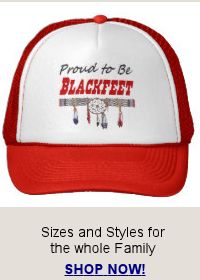 Alexander Culbertson, and other white men who had known these Indians since the 1830’s, stated that “the Blackfeet had possessed horses as far back as their traditions extended but never in considerable numbers in early times, and even as late as 1833 they were poorly mounted.”
Alexander Culbertson, and other white men who had known these Indians since the 1830’s, stated that “the Blackfeet had possessed horses as far back as their traditions extended but never in considerable numbers in early times, and even as late as 1833 they were poorly mounted.”
He estimated that “about the year 1830 the Piegan owned an average of 10 horses per lodge, while the Blood and North Blackfoot averaged but 5 horses per lodge”.
While archaeologists generally believe the ancestors of the modern horse first originated in the Americas, it is a commonly accepted theory that the horse migrated to Asia about 20,000 years ago, when the sea levels were lower and exposed a land bridge , and evolved there, while becoming extinct in the Americas long before they became populated with humans about 10,000 to 12,000 years ago. Most Indian tribes say they have been here much longer than that, too, but that is another story.
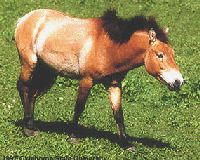 |
| Przewalski Horse |
The modern horse species is thought to be a descendant of the Przewalski horse, which is now extinct except in Mongolia. It is so different, it has 66 chromosomes, compared to the 64 that we find in all other horses.
This is a very primitive kind of horse, one probably quite similar to what ancient peoples first domesticated.
Then again, some researchers believe that the Przewalski Horse represents a whole different species than our domesticated horses, like the donkey, which has 62 chromosomes, or the zebra, which has has between 44 and 62 (depending on species). Two chromosomes is also the difference between humans and apes.
The horses first brought by Columbus, Ponce de Leon, and Cortez were a breed called Spanish Mustangs.
This breed combines the blood of the Arabian, Spanish Barb, Lipizzaners, and Spanish Jennet. These mustangs were the war horses of the Moors, who overran the Spanish. In the 1400s, the Spanish rose up and vanquished the Moors, keeping their small, tough, horses which later became known as the
Spanish Mustang
When Columbus came the New World on his second trip in 1493, Spanish Mustangs were aboard his ships, and when Cortes landed in Mexico in 1519, Spanish Mustangs were brought for use as cavalry horses to invade the Aztec Empire.
Some of these animals escaped and a small number were eventually recaptured by Indians. Others remained wild and were never recaptured. These are called ferrel horses.
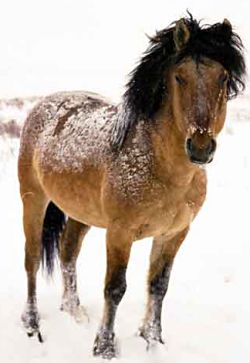 |
| Spanish Mustang |
More Spanish horses were brought over from other lines by later Spanish explorers and conquistidors. These Spanish enslaved the Pueblo Indians and made them work for them mining gold in horrible conditions.
In 1680, the Pueblo Indians revolted against the Spanish rule and the Spaniards left thousands of horses behind in their hasty retreat. The Indians could have rounded up these horses, but chose to let them run wild.
It was much easier to raid the Spanish settlements and steal horses. In an effort to stop the Indian raids, the Spanish government shipped a steady flow of mounts to the New World.
It was hoped that the Indians would catch the “wild” horses and leave the Spaniards alone.
Tens of thousands of the Spanish-bred horses were herded to the Rio Grande and turned loose in a 200-year period. These horses soon met up with draft horses and cowboy ponies that escaped from the ranchers and farmers arriving from the East. Their numbers exceeded two million by the year 1900.
Ranchers took to killing these horses in the mid 1900s to protect the range-land for their cattle. Fewer than 17,000 wild horses remained by the year 1970. In 1971, Congress passed the Wild Free-Roaming Horse and Burro Act. An estimated 41,000 Mustangs roam public range today, but few if any have much original Spanish blood.
The only exception I know of is the Kiger Mustang Herd, which was culled from a larger wild herd and relocated to two specific protected areas set aside for them.
The main line of ferrel horses eventually became known as the American Mustang, best known in the Western United States as the wild horse that is now distributed by the BLM “Adopt A Horse” program.
These wild mustangs are considered a different breed than the Spanish Mustang because they were introduced primarily from mixed lines of Spanish horses, and also interbred heavily with other breeds that escaped from ranchers and settlers later, although the two are often confused and erroneously the terms are sometimes used interchangeably.
The pure Spanish Mustangs are now referred to by a variety of names:
Spanish Barb, Spanish Mustang, Spanish Colonial Horses, to name a few. Examples of specific lines that developed from the Spanish Mustang are the Nez Perce’s famous Appaloosa, which was also slaughtered by the thousands after the surender of the Nez Perce, and the Blackfoot Buffalo Horse. The surviving Nez Perce and Cayuse horses were later crossed with draft horses in an attempt to ruin their use as war ponies.
Some of the original Cortez horses were given to Jesuit Priests in what is now Mexico, who established breeding programs and distributed the horses to the Indian tribes they were trying to convert.
Apache raiding parties found the camps of these tribes who had received horses to be easy targets and soon established a thriving trade economy with their excess horses.
Primarily through the Apache trade network, most of the Plains Indians eventually aquired horses by the early to mid 1700s.
The Comanche became the middlemen in the horse trade between Indian tribes and French settlements east of the Mississippi. Horses spread out of the southwest in primarily two directions.
They moved north to the Ute, who traded with the Shoshone and from them to the Nez Perce, Flatheads, and by 1740 to the Crow. At the same time, the horse trade extended in the north and east to the Kiowa and Pawnee and then to the Arikara.
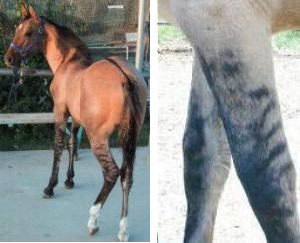 |
| Typical dorsal stripe and “tiger stripes” leg markings of the Spanish Mustang |
It’s generally accepted that the Blackfeet got
horses from the Nez Perce and Flatheads around 1730. Animals bred from their own herds comprised a good proportion of the horses owned by the Blackfoot by the 19th-century buffalo days.
Many Horses and Many-White-Horses are mentioned frequently in discussions of Blackfeet breeding practices, and were among the most sucessful horse breeders.
The Blackfoot believed that those men who were very successful in raising horses possessed a secret power that insured their success in that enterprise.
While the Nez Perce are the only tribe known to have practiced selective breeding, the Blackfeet concentrated on raising Spanish Mustangs to serve as buffalo runners and war horses.
Blackfoot efforts in breeding generally were directed toward producing one or more of three qualities in colts. These were (1) a certain color, (2) large size, and (3) swiftness of foot. While they did not practice selective breeding, allowing their stallions to breed with any mare in the herd they owned, they did select the stallions for a particular trait.
Highly valued buffalo horses were kept inside the lodge at night or picketed nearby. For many tribes, the highest war honor was to take a picketed buffalo horse from an enemy village.
Blackfoot hostility to nearly all neighboring tribes made regular, large-scale trading operations impossible.
Horses were aquired mostly by raids on other tribes, the Flathead and Nez Perce, in particular. A man who owned forty or more horses was considered wealthy in the days of the horse culture.
Horse medicine (ponokâmita saám) was and still is considered the most secret and one of the most powerful medicines of the Blackfoot. Few Blackfoot are willing to discuss its intricacies.
The following seem to have been the most prominent and/or most active horse medicine doctors and Blackfoot horse breeders during the buffalo days: the Piegan Indians Wolf Calf, Fish Child, White Antelope, Boy, and Generous Woman; the Blood Indians Water-Old-Man, Owner-of-Sacred-White-Horse, Many-Spotted-Horses, and Ghost Woman; and the North Blackfoot Indian, Yellow Lodge. Ghost Woman was the only female known to have possessed horse medicine powers.
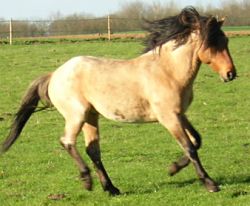 |
| Blackfeet Buffalo Runner Horse |
Among the South Piegan, at least, the horse medicine men comprised an organized cult, the members of which attended the cult ceremony, the horse dance, and exchanged secrets of the uses of specific medicines, and throughout much if not all of the cult’s known history had a recognized leader.
Wolf Calf, also known as Pemmican Maker, was the originator of the horse medicine cult among the Piegan.
Blackfoot elders interviewd in the 1940s recalled that there were herds of wild horses in the Blackfoot Country in their youth.
Lazy Boy attributed their origin to strays from Indian camps, domesticated horses that ran off and became wild after large numbers of Indians died in the early smallpox epidemics.
Blackfoot elders in the 1940s said that very few wild horses were caught by the Blackfoot. Most captured adults died after they reached camp. WeaselHead claimed they could not endure the smoke from lodge fires.
Some colts and yearlings were captured and raised successfully. However the taking of wild horses was confined largely to horse medicine men who had the power to attract those animals with the secret medicines.
The Blackfoot Buffalo Horse is a medium sized horse ranging from 13.2 to 15 hands (a hand is about six inches and is measured at the front shoulder) with an average size of approximately 14.2 hands.
They weigh between approximately 700 and 1200 pounds. They are smooth muscled with short backs, rounded rumps and low set tails.
The feet are extremely sound with thick walls, many having what is typically known as a “mule foot” which resists bruising due to the concave sole. Canons are short, the upper foreleg is long, with the canon bone having a larger circumference than other breeds of comparable size and weight.
The Blackfoot Buffalo Horse is also known for being able to survive on poor grazing conditions that will not support other horse breeds.
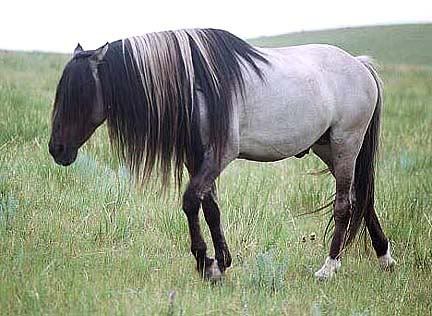
Spanish Mustang with bicolor mane
Colors are extremely varied, representing all the color combinations found in the modern horse but their conformation and size tend to be distinctive.
Specific color traits include a dorsal stripe running from the base of the tail to the withers, although this is more pronounced in some animals than others, not visible on the topcoat in some animals.
Leg markings called tiger stripes or zebra stripes are also common. The Blackfoot Buffalo Horse is also known for it’s extra long tail and mane hair.
Another unusual trait is that the mane and tail hair often starts as one color at the top and is a different color at the tips.
When the Blackfoot tribe was conquered and relocated to the reservation, their horses were confiscated and thousands of them were slaughtered. Like many cultural traditions, the Blackfoot Buffalo Horse was nearly lost.
Then, in 1925, Robert Brislawn of Oshoto, Wyoming, a packer for the U.S. Topographical Service, set out to save the breed. Brislawn bought up the known Spanish Mustangs and began breeding them. In 1957, the Spanish Mustang Registry was formed and horses with proven bloodlines were registered.
Jack Hines, a painter and writer who paints scenes from the old west, visited the Brislawn ranch looking for authentic models of the Indian horse to use for his paintings. Shortly after Hines discovered the Brislawn horses, he visited a man named Bob Black Bull on the Blackfeet Reservation in Northern Montana.
He said he wanted the Blackfeet to have Spanish Mustangs again, so he gave two stallions he bought from the Brislawns to Black Bull. Black Bull had just sold Jack an expensive piece of artwork, so he took the money and bought six mares from the Brislawns.
This was the first herd to return to the Blackfeet Nation since the reservation had been established in the 1800’s. From the beginning, the return of the mustangs stirred a reawakening among tribal members.
Word spread that the first buffalo runners were going to arrive, and on that day, people came from all over the reservation and beyond. “They came by carload and busload, young and old alike, just to see the horses. I think they remembered that these horses were our lifeline to the past,” Black Bull said.
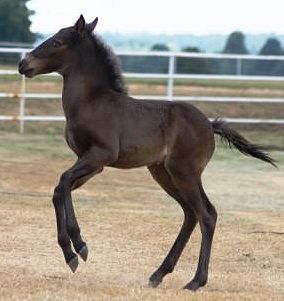 |
| Spanish Mustang Colt |
The Blackfeet Buffalo Horse Coalition, a non-profit corporation, was founded in 1994. Black Bull has established a lease program for people who want personal involvement with the buffalo runners.
An individual or family can lease a stallion and two or three mares at no cost, provided they have an appropriate facility and can provide the necessary hay and grain.
“If they have one foal,” Black Bull explains, “it’s theirs. If they have two, they keep one and one comes back to the base herd. If three foals are involved, they keep two and one comes back.”
The Spanish Mustangs have sparked among tribal members a mental and spiritual return to days gone by.
RELATED LINKS ON THIS SITE:
How a Piegan Warrior Caught the First Horses
A Blackfoot legend about the Piegan Blackfoot who caught the first horses.
How Sky Dogs (the horse) came to the Blackfeet
A story told by a Blackfoot, He-Who-Loves-Horses, about the coming of the first horses to the Blackfoot people.
Another Blackfoot legend explaining how they got horses.
A Blackfoot legend about a special rock that gave power for a good buffalo hunt. It also describes the Blackfoot method of hunting buffalo before they aquired the horse.
Shop for merchandise featuring horses.
Blackfeet Indian Nations: Siksika, Bloods, Peigans, and Browning Blackfeet
Brief overview of the Blackfeet tribes.
Indian symbols used on the war horse
The Indian war horse was highly regarded by its American Indian owner, who often honored and protected his war horse by painting tribal symbols upon the animal’s body.
Indian symbols used on the hunting horse
Since the Indian hunting horse had different duties than that of a war horse, a different set of symbols were used to aid the hunting horse and his rider.
EXTERNAL LINKS:
Blackfeet Buffalo Horse Coalition
The Blackfeet Buffalo Horse Coalition, founded in 1994, was established to bring the Buffalo Runner horse back to the Blackfeet Nation. The BBHC goals are to preserve the Buffalo Runner horse, offer a positive cultural lifestyle to youth, and aid in the creation of a viable economy for the reservation. Bob Black Bull is the executive director.
The first and oldest Mustang Registry for dedicated breeders, owners and enthusiasts of the Spanish Mustang.
The Nokota Horse Conservancy is a nonprofit organization established in 1999 dedicated to preserving the native horse of the Northern Plains called the Nokota horse. Nokota horses are descended from the last surviving population of wild horses in North Dakota
Information on the Adopt-a-Horse-or-Burro program and how to qualify for adoption. This program is run by the Bureau of Land Management.
Florida Cracker Horse Association
Florida Cracker Horses are the descendents of horses brought here by Ponce de Leon in 1521. These horses have been restricted to a relatively small geographical area making them as pure in bloodline, if not more so, than any of the other descendents of early Spanish horses. The name comes from the loud crack of whips used by riders while herding and penning cattle. Cracker horses have been known by a variety of names: Chickasaw Pony, Seminole Pony, March Tackie, Praire Pony, and Grass Gut.
In 1977, during a BLM wild horse roundup, 27 horses were discovered that were strikingly similar in color and conformation. They all carried the dominiant genes which code for the primitive dun factor and the primitive markings of the Spanish mustangs. Genetic tests proved they carry Spanish Mustang genes. These horses were separated from the wild herd and later twenty were released in the Kiger Horse Management Area, and seven in the Riddle HMA in Oregon. The Kiger Mesteño Association was founded in July 1988 to protect and preserve this line and a registry and Standard of Perfection was established for Kiger and half-Kiger horses.
The Przewalski Horse is also known as Asiatic Wild Horse, Mongolian Wild Horse, Mongolian Tarpan, and Taki. This is an article about the history and origin of this animal and its present day counterpart.

